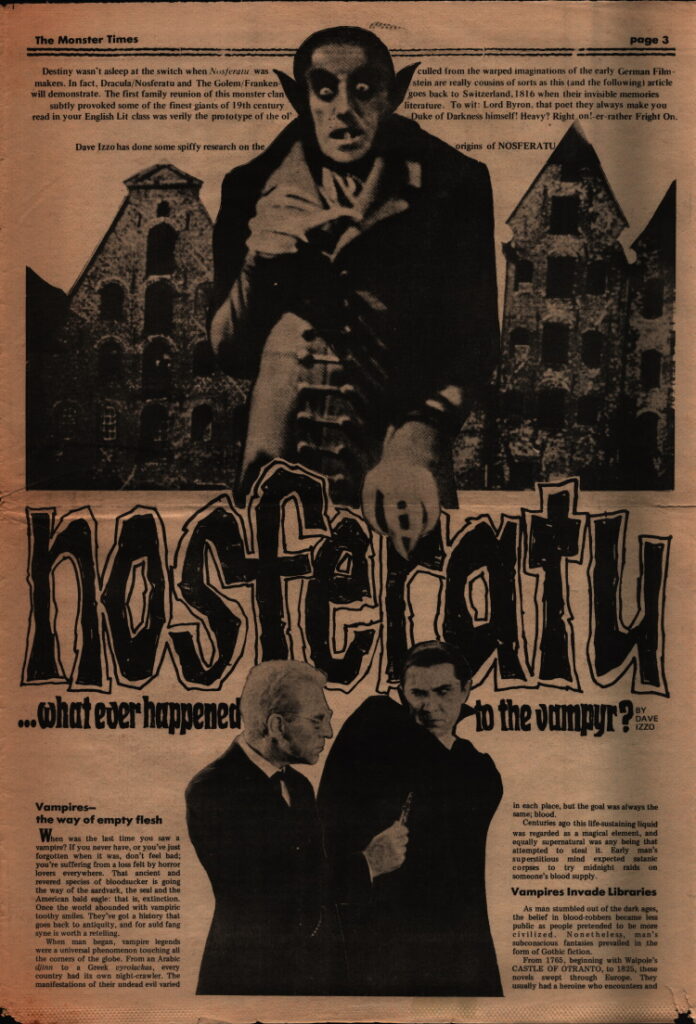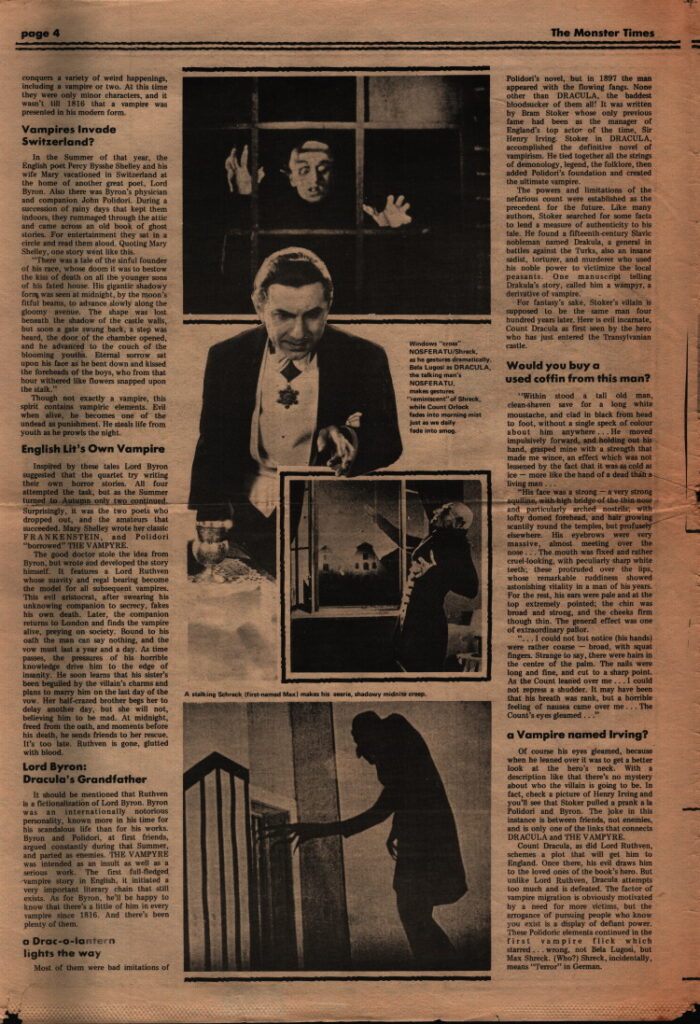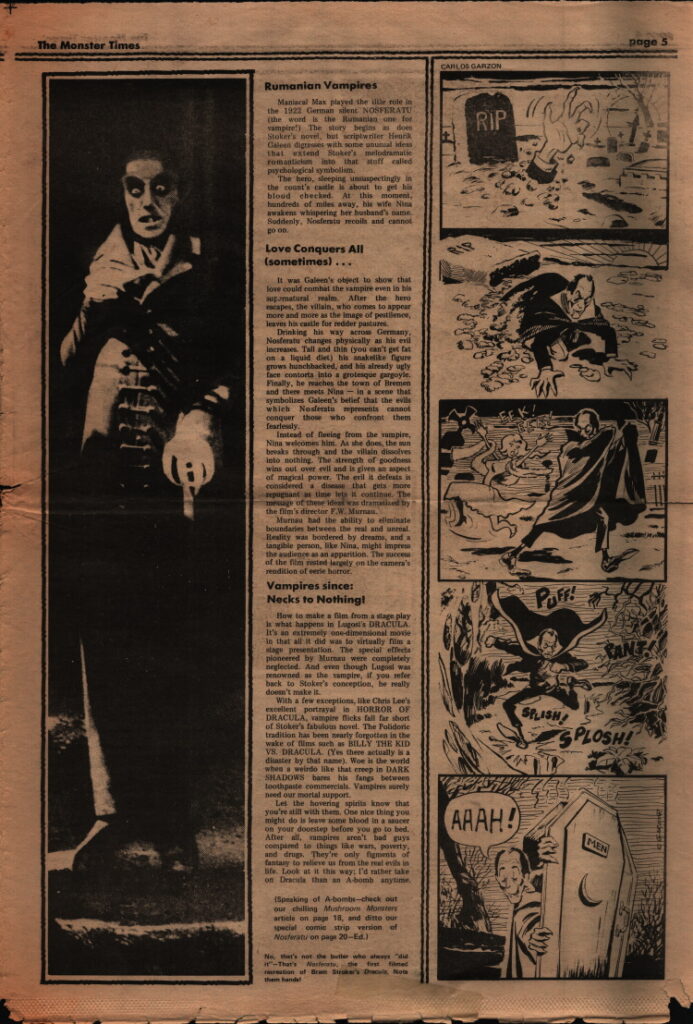By Dave Izzo

Destiny wasn’t asleep at the switch when Nosferatu was culled from the warped imaginations of the early German Film-makers. In fact, Dracula/Nosferatu and The Golem/Frankenstein are really cousins of sorts as this (and the following) article will demonstrate. The first family reunion of this monster clan goes back to Switzerland, 1816 when their invisible memories subtly provoked some of the finest giants of the 19th century literature. To wit: Lord Byron that poet they always make you read in your English Lit class was verily the prototype of the ol’ Duke of Darkness himself! Heavy? Right on!-er-rather Fright On.
Dave Izzo has done some spiffy research on the origins of NOSFERATU
Vampires-
the way of empty flesh
When was the last time you saw a vampire? If you never have, or you’ve just forgotten when it was, don’t feel bad; you’re suffering from a loss felt by horror lovers everywhere. That ancient and revered species of bloodsucker is going the way of the aardvark, the seal and the American bald eagle: that is, extinction. Once the world abounded with vampiric toothy smiles. They’ve got a history that goes back to antiquity, and for auld fang syne is worth a retelling.
When man began, vampire legends were a universal phenomenon touching all the corners of the globe. From an Arabic djinn to a Greek vyrolackas, every country had its own night-crawler. The manifestations of their undead evil varied in each place, but the goal was always the same; blood.
Centuries ago this life-sustaining liquid was regarded as a magical element, and equally supernatural was any being that attempted to steal it. Early man’s superstitious mind expected satanic corpses to try midnight raids on someone’s blood supply.
Vampires Invade Libraries
As man stumbled out of the dark ages, the belief in blood-robbers became less public as people pretended to be more civilized. Nonetheless, man’s subconscious fantasies prevailed in the form of Gothic fiction.
From 1765, beginning with Walpole’s CASTLE OF OTRANTO, to 1825, these novels swept through Europe. They usually had a heroine who encounters and conquers a variety of weird happenings, including a vampire or two. At this time they were only minor characters, and it wasn’t till 1816 that a vampire was presented in his modern form.

Vampires Invade Switzerland?
In the Summer of that year, the English poet Percy Bysshe Shelley and his wife Mary vacationed in Switzerland at the home of another great poet, Lord Byron. Also there was Byron’s physician and companion John Polidori. During a succession of rainy days that kept them indoors, they rummaged through the attic and came across an old book of ghost stories. For entertainment they sat in a circle and read them aloud. Quoting Mary Shelley, one story went like this.
“There was a tale of the sinful founder of his race, whose doom it was to bestow the kiss of death on all the younger sons of his fated house. His gigantic shadowy form was seen at midnight, by the moon’s fitful beams, to advance slowly along the gloomy avenue. The shape was lost beneath the shadow of the castle walls, but soon a gate swung back, a step was heard, the door of the chamber opened, and he advanced to the couch of the blooming youths. Eternal sorrow sat upon his face as he bent down and kissed the foreheads of the boys, who from that hour withered like flowers snapped upon the stalk.”
Though not exactly a vampire, this spirit contains vampiric elements. Evil when alive, he becomes one of the undead as punishment. He steals life from youth as he prowls the night.
English Lit’s Own Vampire
Inspired by these tales Lord Byron suggested that the quartet try writing their own horror stories. All four attempted the task, but as the Summer turned to Autumn only two continued. Surprisingly, it was the two poets who dropped out, and the amateurs that succeeded. Mary Shelley wrote her classic FRANKENSTEIN, and Polidori “borrowed” THE VAMPYRE.
The good doctor stole the idea from Byron, but wrote and developed the story himself. It features a Lord Ruthven whose suavity and regal bearing become the model for all subsequent vampires. This evil aristocrat, after swearing his unknowing companion to secrecy, fakes his own death. Later, the companion returns to London and finds the vampire alive, preying on society. Bound to his oath the man can say nothing, and the vow must last a year and a day. As time passes, the pressures of his horrible knowledge drive him to the edge of insanity. He soon learns that his sister’s been beguiled by the villain’s charms and plans to marry him on the last day of the vow. Her half-crazed brother begs her to delay another day, but she will not, believing him to be mad. At midnight, freed from the oath, and moments before his death, he sends friends to her rescue. It’s too late. Ruthven is gone, glutted with blood.
Lord Byron: Dracula’s Grandfather
It should be mentioned that Ruthven is a fictionalization of Lord Byron. Byron was an internationally notorious personality, known more in his time for his scandalous life than for his works. Byron and Polidori, at first friends, argued constantly during that Summer, and parted as enemies. THE VAMPYRE was intended as an insult as well as a serious work. The first full-fledged vampire story in English, it initiated a very important literary chain that still exists. As for Byron, he’ll be happy to know that there’s a little of him in every vampire since 1816. And there’s been plenty of them.
a Drac-o-lantern lights the way
Most of them were bad imitations of Polidori’s novel, but in 1897 the man appeared with the flowing fangs. None other than DRACULA, the baddest bloodsucker of them all! It was written by Bram Stoker whose only previous fame had been as the manager of England’s top actor of the time, Sir Henry Irving. Stoker in DRACULA, accomplished the definitive novel of vampirism. He tied together all the strings of demonology, legend, the folklore, then added Polidori’s foundation and created the ultimate vampire.
The powers and limitations of the nefarious count were established as the precedent for the future. Like many authors, Stoker searched for some facts to lend a measure of authenticity to his tale. He found a fifteenth-century Slavic nobleman named Drakula, a general in battles against the Turks, also an insane sadist, torturer, and murderer who used his noble power to victimize the local peasants. One manuscript telling Drakula’s story, called him a wampyr, a derivative of vampire.
For fantasy’s sake, Stoker’s villain is supposed to be the same man four hundred years later. Here is evil incarnate, Count Dracula as first seen by the hero who has just entered the Transylvanian castle.
Would you buy a used coffin from this man?
“Within stood a tall old man, clean-shaven save for a long white moustache, and clad in black from head to foot, without a single speck of colour about him anywhere… He moved impulsively forward, and holding out his hand, grasped mine with a strength that made me wince, an effect which was not lessened by the fact that it was as cold as ice – more like the hand of a dead than a living man…
“His face was a strong – a very strong aquiline, with high bridge of the thin nose and particularly arched nostrils, with lofty domed forehead, and hair growing scantily round the temples, but profusely elsewhere. His eyebrows were very massive, almost meeting over the nose… The mouth was fixed and rather cruel-looking, with peculiarly sharp white teeth; these protruded over the lips, whose remarkable ruddiness showed astonishing vitality in a man of his years. For the rest, his ears were pale and at the top extremely pointed; the chin was broad and strong, and the cheeks firm though thin. The general effect was one of extraordinary pallor.
“… I could not but notice (his hands) were rather coarse – broad, with squat fingers. Strange to say, there were hairs in the centre of the palm. The nails were long and fine, and cut to a sharp point. As the Count leaned over me… I could not repress a shudder. It may have been that his breath was rank, but a horrible feeling of nausea came over me… The Count’s eyes gleamed…”
a Vampire named Irving?
Of course his eyes gleamed, because when he leaned over it was to get a better look at the hero’s neck. With a description like that there’s no mystery about who the villain is going to be. In fact, check a picture of Henry Irving and you’ll see that Stoker pulled a prank a la Polidori and Byron. The joke in this instance is between friends, not enemies, and is only one of the links that connects DRACULA and THE VAMPYRE.
Count Dracula, as did Lord Ruthven, schemes a plot that will get him to England. Once there, his evil draws him to the loved ones of the book’s hero. But unlike Lord Ruthven, Dracula attempts too much and is defeated. The factor of vampire migration is obviously motivated by a need for more victims, but the arrogance of pursuing people who know you exist is a display of defiant power. These Polidoric elements continued in the first vampire flick which starred… wrong, not Bela Lugosi, but Max Shreck. (Who?) Shreck, incidentally, means “Terror” in German.

Rumanian Vampires
Maniacal Max played the title role in the 1922 German silent NOSFERATU (the word is the Rumanian one for vampire!) The story begins as does Stoker’s novel, but scriptwriter Henrik Galeen digresses with some unusual ideas that extend Stoker’s melodramatic romanticism into that stuff called psychological symbolism.
The hero, sleeping unsuspectingly in the count’s castle is about to get his blood checked. At this moment, hundreds of miles away, his wife Nina awakens whispering her husband’s name. Suddenly, Nosferatu recoils and cannot go on.
Love Conquers All (sometimes)…
It was Galeen’s object to show that love could combat the vampire even in his supernatural realm. After the hero escapes, the villain, who comes to appear more and more as the image of pestilence, leaves his castle for redder pastures.
Drinking his way across Germany, Nosferatu changes physically as his evil increases. Tall and thin (you can’t get fat on a liquid diet) his snakelike figure grows hunchbacked, and his already ugly face contorts into a grotesque gargoyle. Finally, he reaches the town of Bremen and there meets Nina – in a scene that symbolizes Galeen’s belief that the evils which Nosferatu represents cannot conquer those who confront them fearlessly.
Instead of fleeing from the vampire, Nina welcomes him. As she does, the sun breaks through and the villain dissolves into nothing. The strength of goodness wins out over evil and is given an aspect of magical power. The evil it defeats is considered a disease that gets more repugnant as time lets it continue. The message of these ideas was dramatized by the film’s director F.W. Murnau.
Murnau had the ability to eliminate boundaries between the real and unreal. Reality was bordered by dreams, and a tangible person, like Nina, might impress the audience as an apparition. The success of the film rested largely on the camera’s rendition of eerie horror.
Vampires since: Necks to Nothing!
How to make a film from a stage play is what happens in Lugosi’s DRACULA. It’s an extremely one-dimensional movie in that all it did was to virtually film a stage presentation. The special effects pioneered by Murnau were completely neglected. And even though Lugosi was renowned as the vampire, if you refer back to Stoker’s conception, he really doesn’t make it.
With a few exceptions, like Chris Lee’s excellent portrayal in HORROR OF DRACULA, vampire flicks fall far short of Stoker’s fabulous novel. The Polidoric tradition has been nearly forgotten in the wake of films such as BILLY THE KID VS. DRACULA. (Yes there actually is a disaster by that name). Woe is the world when a weirdo like that creep in DARK SHADOWS bares his fangs between toothpaste commercials. Vampires surely need our mortal support.
Let the hovering spirits know that you’re still with them. One nice thing you might do is leave some blood in a saucer on your doorstep before you go to bed. After all, vampires aren’t bad guys compared to things like wars, poverty, and drugs. They’re only figments of fantasy to relieve us from the real evils in life. Look at it this way; I’d rather take on Dracula than an A-bomb anytime.
(Speaking of A-bombs-check out our chilling Mushroom Monsters article on page 18, and ditto our special comic strip version of Nosferatu on page 20-Ed.)
No, that’s not the butler who always “did it”-That’s Nosferatu, the first filmed recreation of Bram Stroker’s Dracula. Note them hands!
